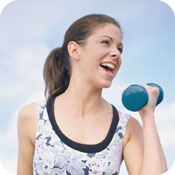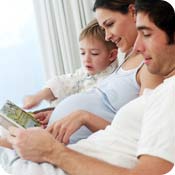
After the first trimester, when most experts recommend that you don't lie on your back to exercise, you can still lie on a stability ball in an inclined position to do chest presses and crunches. (If you don't feel completely stable using the ball by yourself, have someone hold it for you.)
In fact, the benefits of using the ball during pregnancy and birth are almost endless:
- Sitting on a stability ball (and getting up) may be easier and more comfortable than using a chair in late pregnancy.
- Increases pelvic mobility.
- Uses gravity in the sitting or squatting position to assist in fetal descent.
- Provides perineal support without undue pressure.
- Lessens strain on the hands and arms in the hands-knees position.
- Provides a softer surface than a chair for sitting.
- May speed up labor.
- Supports squatting during birth, which helps widen the pelvic outlet to its maximum.
- Aids the use of other techniques designed to counteract "failure to progress," thus lessening the likelihood that Caesarean delivery will be needed.
- Kneeling and leaning over the ball helps re-position a posterior baby to anterior.
The birth ball provides a variety of positions during birth without interfering with fetal monitoring, and can even be used with a light epidural anesthesia. In studies done to ascertain which position is most beneficial during the second stage of labor-- the pushing stage-- experts concluded that sitting up or lying on your side to push instead of lying on your back results in:
- A shorter second stage of labor.
- A small reduction in assisted delivery (where vacuum and forceps are necessary).
- A reduction in episiotomies.
- A smaller increase in second-degree perineal tears.
- Reduced reports of severe pain during the second stage of labor.
- Fewer abnormal fetal heart rate patterns.
Postpartum, the ball provides a softer, more comfortable surface to sit on than many chairs. You can use it as a rocker, sitting and swaying or bouncing lightly. The ball has also been shown to help with colic, by allowing you to place the baby on its stomach on the ball.
Costing between $18-$40, the balls are available in a variety of sizes suited to different heights. They're a great investment, not only for the childbearing years, but also for lifelong exercise benefits. And-- in this season of exchanging gifts-- they'd be a novel present under the Christmas tree for your favorite mom-to-be!
Check out BabyFit's Exercise Demos for pictures and detailed instructions for exercises (and stretches) you can do with a stability ball.
|







Member Comments